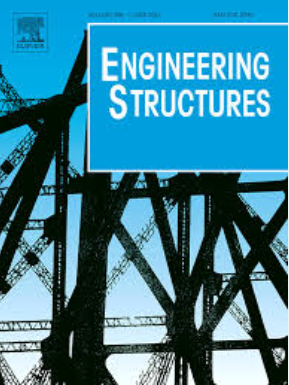轴压和偏心压作用下GLB柱的耐火性能:试验与数值研究
IF 6.4
1区 工程技术
Q1 ENGINEERING, CIVIL
引用次数: 0
摘要
由于其碳封存和可再生特性,胶合层压竹(GLB)作为一种结构材料具有巨大的潜力。然而,其可燃性引起了人们对其耐火性的担忧。采用实验和数值研究相结合的方法,在考虑不同长细比、载荷比、偏心距等因素的影响下,按照ISO 834标准曲线,对GLB柱在四面火暴露下的抗压性能进行了研究。结果表明:轴压作用下GLB柱的耐火性能随长细比和荷载比的增大而减小;对于偏心受压的GLB柱,其耐火性能随偏心的增大而略有下降。破坏模式以拉伸侧纤维断裂为主。热-力耦合分析准确地模拟了GLB柱的温度分布和力学行为,实验结果与模拟结果的炭化深度和耐火性能误差均在10 %以内。研究揭示了GLB柱在压缩作用下的破坏模式和耐火性能,为GLB结构的设计和防火提供了重要的理论和实践参考。本文章由计算机程序翻译,如有差异,请以英文原文为准。
Fire resistance of GLB columns under axial and eccentric compression: Experimental and numerical investigation
Due to its carbon-sequestering, and renewable properties, glued laminated bamboo (GLB) holds significant potential as a structural material. However, its combustibility raises concerns about its fire resistance. This paper uses experimental and numerical investigation to study the compressive performance of GLB columns exposed to four-side fire exposure following the ISO 834 standard curve, considering the effects of different slenderness ratio, load ratio, and eccentricity. It is found that for GLB columns subjected to axial compression, the fire resistance decreases with increasing slenderness ratio and load ratio. For GLB columns under eccentric compression, the fire resistance shows a slight decline as the eccentricity increases. The failure mode is dominated by fiber rupture on the tensile side. The thermo-mechanical coupling analysis accurately simulated the temperature distribution and mechanical behavior of GLB columns, with errors for charring depth and fire resistance both within 10 % between experimental and simulated results. This study reveals the failure modes and fire resistance of GLB columns under compression, and provides essential theoretical and practical references for designing and fireproofing GLB structures.
求助全文
通过发布文献求助,成功后即可免费获取论文全文。
去求助
来源期刊

Engineering Structures
工程技术-工程:土木
CiteScore
10.20
自引率
14.50%
发文量
1385
审稿时长
67 days
期刊介绍:
Engineering Structures provides a forum for a broad blend of scientific and technical papers to reflect the evolving needs of the structural engineering and structural mechanics communities. Particularly welcome are contributions dealing with applications of structural engineering and mechanics principles in all areas of technology. The journal aspires to a broad and integrated coverage of the effects of dynamic loadings and of the modelling techniques whereby the structural response to these loadings may be computed.
The scope of Engineering Structures encompasses, but is not restricted to, the following areas: infrastructure engineering; earthquake engineering; structure-fluid-soil interaction; wind engineering; fire engineering; blast engineering; structural reliability/stability; life assessment/integrity; structural health monitoring; multi-hazard engineering; structural dynamics; optimization; expert systems; experimental modelling; performance-based design; multiscale analysis; value engineering.
Topics of interest include: tall buildings; innovative structures; environmentally responsive structures; bridges; stadiums; commercial and public buildings; transmission towers; television and telecommunication masts; foldable structures; cooling towers; plates and shells; suspension structures; protective structures; smart structures; nuclear reactors; dams; pressure vessels; pipelines; tunnels.
Engineering Structures also publishes review articles, short communications and discussions, book reviews, and a diary on international events related to any aspect of structural engineering.
 求助内容:
求助内容: 应助结果提醒方式:
应助结果提醒方式:


